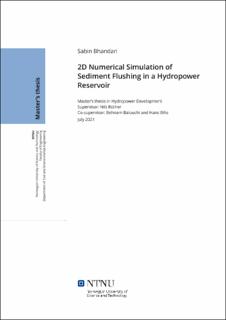| dc.description.abstract | The Binga Hydropower Plant has been facing problems related to sedimentation. After completion, reservoir was filled up rapidly with sediment due to lack of sediment management facility and the underestimation of sediment load from the catchment area. The sediment delta is approaching near the dam which have potential to seriously damage the hydraulic structure and plant's units. Due to sedimentation rate of storage loss increases so, flushing of sediment out of reservoir is crucial to reduce the possible threat imposed by delta and to operate Binga as a run-of river project. So, the primary idea of this topic is to investigate the technical possibilities to use a 2D numerical model to flush sediment out of reservoir during draw down operation.
A 2D numerical model with structured immersed boundary condition to generate grid from topographic data was used for simulation. The numerical model of hydrodynamic simulation (scale of 1:66.67, as implemented for physical model) is carried out which first calibrated and validated against the measured inflow velocity profile and water surface elevation at different control points in the physical model. The model is simulated using different range of global roughness value. Based on the flow pattern, velocity distribution profile global roughness of 0.166 is chosen for further simulation analysis.
Sediment simulation is carried out using average sediment size d50 for two different constant discharge conditions i.e. 500 m 3/sec and 1000 m 3/sec to observe the scour and deposition pattern. The time development of deposition and erosion is observed. Conservative finite-difference framework on structured-staggered grid was used to descretize RANS (Reynolds-Averaged Stokes (RANS) equation with fifth-order WENO (weighted essentially non-oscillatory) scheme and third-order Runge-Kutta explicit scheme was used for time discretization. The location of free surface is presented using level set method. Domain decomposition coupled with MPI library is used to achieve the parallelization of numerical model. The complex geometry in numerical model area handled with an immersed boundary method based on ghost cell extrapolation.
In the final stage, the scouring and deposition pattern is modelled for both discharges. The numerical result is compared with the data obtained from the experiment conducted in Norsk Hydroteknisk Laboratorium, Norwegian University of Science and Technology (NTNU). The comparison is done on the basis of change in bed level by computing the raster map of both physical and simulated topographic data. The validation is also done by computing the change in volume of bed in the areas where scouring and deposition process was occurred on the basis of raster map using Arcgis.
In context of flushing with 500 m 3/sec the scouring and deposition pattern and the change in bed volume is in well agreement with physical model. While in 1000 m 3/sec simulated results in terms of deposition and scouring pattern is different and volume is overestimated as compared to physical model. | |
